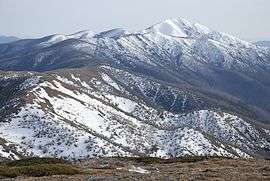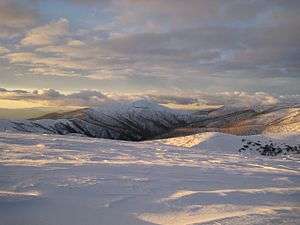Australian Alps
| Australian Alps Australia | |||||||||||||||
|---|---|---|---|---|---|---|---|---|---|---|---|---|---|---|---|
 Mount Feathertop, Victoria | |||||||||||||||
 | |||||||||||||||
| Area | 12,330 km2 (4,760.6 sq mi) | ||||||||||||||
| |||||||||||||||
The Australian Alps, an interim Australian bioregion,[1][2] is the highest mountain range in Australia. This range is located in southeastern Australia, and it straddles eastern Victoria, southeastern New South Wales, and the Australian Capital Territory. The Australian Alps contain Australia's only peaks exceeding 2,000 metres (6,600 ft) in elevation above sea level. The Alps are the only bioregion on the Australian mainland in which deep snow falls annually. The Alps comprise an area of 1,232,981 hectares (3,046,760 acres).[3]
The Australian Alps are part of the Great Dividing Range, the series of mountains, hills, and highlands that runs about 3,000 kilometres (1,900 mi) from northern Queensland, through New South Wales, and into the northern part of Victoria.[4] This chain of highlands divides the drainage of the rivers that flow to the east into the Tasman Sea from those that flow west into the drainage of the Murray–Darling basin (and thence to the Southern Ocean) or into inland waters, such as Lake Eyre, which lie below sea level, or else evaporate rapidly. The Great Dividing Range reaches its greatest heights in the Australian Alps.
The Australian Alps consist of two biogeographic subregions: the Snowy Mountains including the Brindabella Range, located in New South Wales and the Australian Capital Territory; and the Victorian Alps, located in Victoria. The latter region is also known as the "High Country", particularly within a cultural or historical context.
Australia's mountains have a reputation of being quite short, despite numerous mountains in the Australian Alps exceeding Mount Narodnaya, the tallest of the Ural Mountains of Russia, while Mount Kosciuszko is taller than all but one mountain in eastern Canada, including all mountains on the Eastern side of mainland Canada, and much of the eastern United States of America.
Ecology
The Australian Alps are important for conservation, recreation, and as a water drainage basin, with much of their eastern slopes having its runoff diverted artificially into the Murray River and its tributary the Murrumbidgee River through the civil engineering project of the Snowy Mountains Scheme.
They are protected by large national parks, in particular the Kosciuszko National Park in New South Wales and the Alpine National Park in Victoria. These are managed cooperatively as Australian Alps National Parks by agencies of the Australian Government and the state governments of this region.
The Australian Alps also contain the only skiing areas of mainland Australia. Along with the town of Cabramurra, New South Wales, these are practically the only permanent settlements in the area. Several medium-sized towns can be found in the valleys below the foothills, such as Jindabyne, New South Wales, Corryong, Victoria, and Mount Beauty.
The Australian Alps are not as high or as steep as the Alps of Europe, New Zealand's Southern Alps, or the Andes Mountains, and most of their peaks can be reached without using mountaineering equipment.
Birds
The Australian Alps have been classified by BirdLife International as an Important Bird Area. Their montane forests and woodlands support large breeding populations of flame robins and pilotbirds.[5]
Bushfires
Due to its mostly hot, dry climate, bushfires in Australia occur frequently, particularly in the well forested areas of the Australian Alps. The Alps, particularly the Victorian Alps, are periodically subject to major bushfires and have been almost entirely burnt through by bushfires on various occasions, notably; Black Thursday in 1851, Black Friday (1939), and during fires in 2003 and 2006-07.
Certain native flora in Australia have evolved to rely on bushfires as a means of reproduction and fire events are an interwoven and an essential part of the ecology of the continent. In some eucalypt and banksia species, for example, fire causes seed pods to open, which allows them to germinate. Fire also encourages the growth of new grassland plants. Other species have adapted to recover quickly from fire.
Nevertheless, damage to surrounding human habitations and native fauna can be extensive and occasionally catastrophic. The 2003 Canberra bushfires severely affected almost 70% of the Australian Capital Territory’s pasture, forests (pine plantations) and nature parks. After burning for a week through the Brindabella Ranges above Canberra, the fires entered the suburbs of the city on 18 January 2003. Four people died and more than 500 homes were destroyed or severely damaged. The Victorian Black Saturday bushfires were particularly intense in parts of the Victorian Highcountry and destroyed several towns, including Kinglake and Marysville. The fires killed 173 people, Australia's highest ever loss of life from a bushfire.[6] Statewide, the fires affected 78 townships and destroyed over 2,030 houses, 3,500+ structures.[7]
Alpine huts
Within the Australian Alps there are about 120 active alpine huts that mostly date back to the early cattlemen's days, early skiing huts, and early research and surveying huts. Many of these have remained in use by fly fishers (seasonal), hikers and skiing groups throughout the year. Most of these huts are maintained by volunteers through the Kosciuszko Huts Association and the local National Parks and Wildlife Service.
Some of the more noteworthy huts include Moscow Villa Hut, Valentine Hut, Seaman's Hut and Mawsons Hut. In recent years many huts have been lost through lack of maintenance and bush fire - as occurred with the Pretty Plain Hut and Mount Franklin Chalet, which were destroyed by the Canberra bushfires of 2003.
Gallery
- The Australian Alps viewed from Snowy River Road, near Suggan Buggan, State of Victoria.

 Sunset over the Alps from Mount Hotham, Victoria.
Sunset over the Alps from Mount Hotham, Victoria.- Talbingo Dam, a part of the Snowy Mountains Scheme.
 Yarrangobilly Caves, located off the Snowy Mountains Highway.
Yarrangobilly Caves, located off the Snowy Mountains Highway.- The restored former courthouse and ski chalet of Kiandra, where skiing in Australia began.
 The Kosciuszko Main Range seen from Charlotte Pass ski resort.
The Kosciuszko Main Range seen from Charlotte Pass ski resort. Mount Feathertop seen from Mount Hotham.
Mount Feathertop seen from Mount Hotham. Perisher, New South Wales, is Australia's largest ski resort.
Perisher, New South Wales, is Australia's largest ski resort.- Sunset over Kiandra
Attractions
- Australian Alps Walking Track: a long distance walking trail through the alpine areas of Victoria, New South Wales, and the ACT. It is 655 kilometres (407 mi) long, starting at Walhalla, Victoria and running through to Tharwa, ACT near Canberra.
|
|
|
Resort skiing areas
The Australian Alps are the main region in which skiing in Australia takes place (although skiing is also possible in Tasmania). Skiable terrain stretches through large areas of territory from June to October. New South Wales is home to Australia's highest snow country, oldest skifields and largest resort. Recreational skiing in Australia began around 1861 at Kiandra, New South Wales, when Norwegian gold miners introduced the idea to the frozen hills around the town.[8] The first and longest surviving ski club in the world, The Kiandra Snow Shoe Club is believed to have been formed at Kiandra in that year.[9][10] Steeper slopes and more reliable snows lie further to the south and in the 20th century, the focus of recreational skiing in New South Wales shifted southward, to mountains in and around the Kosciuszko Main Range region, where Australia's best vertical drop is found at Thredbo and Australia's biggest resort, Perisher is now found. The State of Victoria is the one with the largest number of skiing areas in Australia.[11]
Mount Bogong, with its peak at 1986 metres above sea level, is the highest peak in Victoria. The surrounding Bogong High Plains is one of the largest areas of snow country in Australia. It includes the leading resorts of Falls Creek and Mount Hotham.[12] Recreational and practical skiing was being practised in the Victorian Alps by the 1880s and 1890s with skis made from local timbers, and making use of single steering poles.[13] Skiing began at Mount Buffalo in the 1890s and a Chalet was constructed in 1910. Australia's first ski tow was constructed near Mount Buffalo in 1936.[14]
Cross country skiing is possible in the Australian Capital Territory as well as in New South Wales and Victoria, but downhill skiing can only be done in New South Wales and Victoria:
|
|
Panoramas




References
- ↑ Environment Australia. "Revision of the Interim Biogeographic Regionalisation for Australia (IBRA) and Development of Version 5.1 - Summary Report". Department of the Environment and Water Resources, Australian Government. Archived from the original on 2006-09-05. Retrieved 2007-01-31.
- ↑ IBRA Version 6.1 data
- ↑ "Interim Biogeographic Regionalisation for Australia (IBRA7) regions and codes". Department of Sustainability, Environment, Water, Population and Communities. Commonwealth of Australia. 2012. Retrieved 13 January 2013.
- ↑ "Geology of the Australian alps" (PDF). p. 1. Retrieved 30 November 2013.
The Australian Alps are the highest part of a larger entity, the Eastern Highlands of Australia...
- ↑ "IBA: Australian Alps". Birdata. Birds Australia. Retrieved 2011-05-19.
- ↑ Huxley, John (11 February 2009). "Horrific, but not the worst we've suffered". Fairfax Media. Sydney Morning Herald. Archived from the original on 13 February 2009. Retrieved 11 February 2009.
- ↑ "Victorian Bushfires". Parliament of New South Wales. New South Wales Government. 13 March 2009. Retrieved 14 December 2009.
- ↑ "Kiandra - Culture and History". The Sydney Morning Herald. 21 November 2008. Retrieved 2010-05-04.
- ↑ "History". Selwyn Snowfields website. Retrieved 2010-05-04.
- ↑ Clarke, Norman W. (2006). Kiandra: goldfields to skifields. Kiandra Pioneer Ski Club (1870) Ltd. ISBN 0-646-46337-3.
- ↑ "404". australia.com. Archived from the original on 10 February 2012. Retrieved 25 January 2016.
- ↑ Archived April 6, 2010, at the Wayback Machine.
- ↑ "Missing Page or Broken Link - Australian Alpine Club". australianalpineclub.com. Retrieved 25 January 2016.
- ↑ "National Parks and Reserves of the Australian Alps - Mount Buffalo National Park". Australianalps.environment.gov.au. Retrieved 2016-01-25.